This tutorial will show how you can use Google Cloud and Ploomber to develop a scalable and production-ready pipeline.
We’ll use Google BigQuery (data warehouse) and Cloud Storage to show how we can transform big datasets with ease using SQL, plot the results with Python, and store the results in the cloud. Thanks to BigQuery scalability (we’ll use a dataset with 5.5M records!) and Ploomber’s convenience, the entire process from importing the data to the summary report is on the cloud takes less than 20 seconds!
Introduction
Before we begin, I’ll quickly go over two Google Cloud services we use for this project. Google BigQuery is a serverless data warehouse that allows us to analyze data at scale. In simpler terms, we can store massive datasets and query using SQL without managing servers. On the other hand, Google Cloud Storage is a storage service; it is the equivalent service to Amazon S3.
Since our analysis comprises SQL and Python, we use Ploomber, an open-source framework to write maintainable pipelines. It abstracts all the details, so we focus on writing the SQL and Python scripts.
Finally, the data. We’ll be using a public dataset that contains statistics of people’s names in the US over time. The dataset contains 5.5M records. Here’s what it looks like:

Let’s now take a look at the pipeline’s architecture!
Architecture overview

The first step is the create-table.sql script; such script runs a CREATE TABLE statement to copy a public dataset. create-view.sql and create-materialized-view.sql use the existing table and generate a view and a materialized view (their purpose is to show how we can create other types of SQL relations, we don’t use the outputs).
The dump-table.sql queries the existing table, and it dumps the results into a local file. Then, the plot.py Python script uses the local data file, generates a plot, and uploads it in HTML format to Cloud Storage. The whole process may seem intimidating, but Ploomber makes this straightforward!
Let’s now configure the cloud services we’ll use!
Setup
We need to create a bucket in Cloud Storage and a dataset in BigQuery; the following sections explain how to do so.
Cloud Storage
Go to the Cloud Storage console (select a project or create a new one, if needed) and create a new bucket (you may use an existing one if you prefer so). In our case, we’ll create a bucket “ploomber-bucket” under the project “ploomber”:
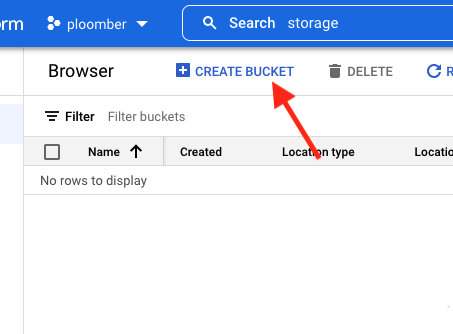
Then, enter a name (in our case “ploomber-bucket”), and click on “CREATE”:
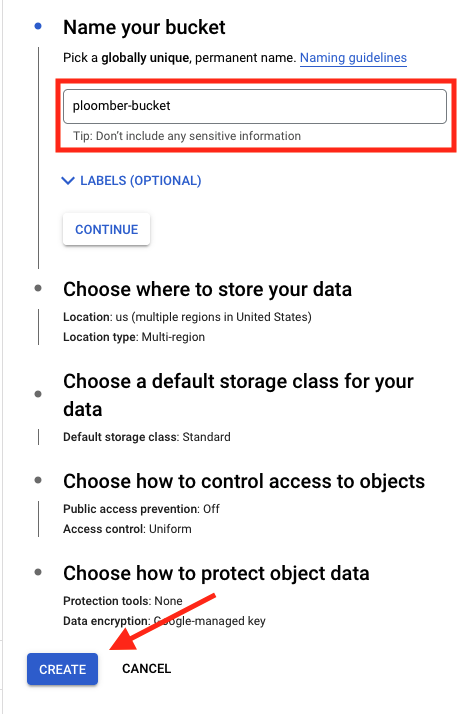
Let’s now configure BigQuery.
BigQuery
Go to the BigQuery console and create a dataset. To do so, click on the three stacked dots next to your project’s name and then click on “Create dataset”:
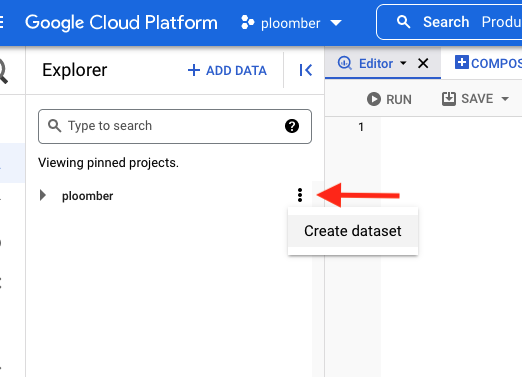
Now, enter “my_dataset” as the Dataset ID and “us” in Data location (location is important since we’ll be using a public dataset located in such region), then click on “CREATE DATASET”:
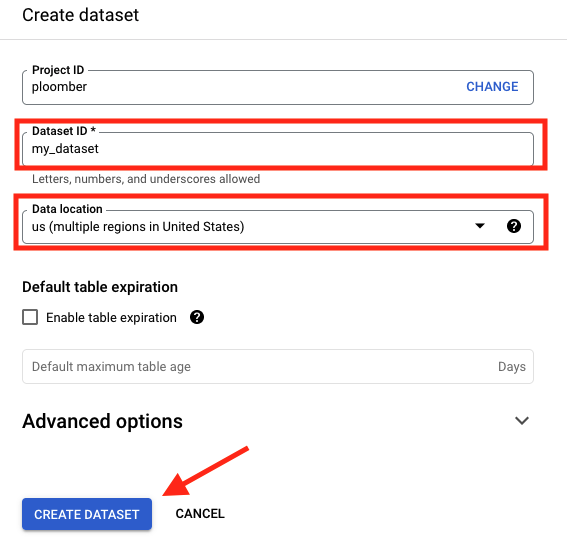
Google Cloud is ready now! Let’s now configure our local environment.
Local setup
First, let’s authenticate so we can make API calls to Google Cloud. Ensure you authenticate with an account that has enough permissions in the project to use BigQuery and Cloud Storage:
gcloud auth login
If you have trouble, check the docs.
Now, let’s install Ploomber to get the code example:
# note: this example requires ploomber 0.19.2 or higher
pip install ploomber --upgrade
# download example
ploomber examples -n templates/google-cloud -o gcloud
# move to the example folder
cd gcloud
Let’s now review the structure of the project.
Project structure
pipeline.yamlPipeline declarationclients.pyFunctions to create BigQuery and Cloud Storage clientsrequirements.txtPython dependenciessql/SQL scripts (executed in BigQuery)scripts/Python scripts (executed locally, outputs uploaded to Cloud Storage)
You can look at the files in detail here. For this tutorial, I’ll quickly mention a few crucial details.
pipeline.yaml is the central file in this project; Ploomber uses this file
to assemble your pipeline and run it, here’s what it looks like:
# Content of pipeline.yaml
tasks:
# NOTE: ensure all products match the dataset name you created
- source: sql/create-table.sql
product: [my_dataset, my_table, table]
- source: sql/create-view.sql
product: [my_dataset, my_view, view]
- source: sql/create-materialized-view.sql
product: [my_dataset, my_materialized_view, view]
# dump data locally (and upload outputs to Cloud Storage)
- source: sql/dump-table.sql
product: products/dump.parquet
chunksize: null
# process data with Python (and upload outputs to Cloud Storage)
- source: scripts/plot.py
product: products/plot.html
Each task in the pipeline.yaml file contains two elements: the source code
we want to execute and the product. You can see that we have a few SQL scripts
that generate tables and views. However, the dump-table.sql creates a
.parquet file. This indicates to Ploomber that it should download the results
instead of storing them on BigQuery. Finally, the plot.py script contains an
.html output; Ploomber will automatically run the script and store the
results in the HTML file.
You might be wondering how the order is determined. Ploomber extracts references
from the source code itself; for example, the create-view.sql depends on
create-table.sql. If we look at the code, we’ll see the reference:
# Content of sql/create-view.sql
DROP VIEW IF EXISTS {{ product }};
CREATE VIEW {{ product }} AS
SELECT *
FROM {{ upstream["create-table"] }}
There is a placeholder {{ upstream["create-table"] }}, this indicates
that we should run create-table.sql first. At runtime, Ploomber will replace
the placeholder for the table name. We also have a second placeholder
{{ product }}, this will be replaced by the value in the pipeline.yaml file.
That’s it for the pipeline.yaml. Let’s review the clients.py file.
Configure clients.py
clients.py contains a function that returns clients to communicate with
BigQuery and Cloud Storage.
For example, this is how we connect to BigQuery:
# Content of clients.py
def db():
"""Client to send queries to BigQuery
"""
return DBAPIClient(connect, dict())
Note that we’re returning a ploomber.clients.DBAPIClient object. Ploomber
wraps BigQuery’s connector, so it works with other databases.
Secondly, we configure the Cloud Storage client:
# Content of clients.py
def storage():
"""Client to upload files to Google Cloud Storage
"""
# ensure your bucket_name matches
return GCloudStorageClient(bucket_name='ploomber-bucket',
parent='my-pipeline')
Here, we return a ploomber.clients.GCloudStorageClient object (ensure
that the bucket_name matches yours!)
Great, we’re ready to run the pipeline!
Running the pipeline
Ensure your terminal is open in the gcloud folder and execute the following:
# install dependencies
pip install -r requirements.txt
# run the pipeline
ploomber build
After a few seconds of running the ploomber build command, you should see
something like this:
name Ran? Elapsed (s) Percentage
------------------------ ------ ------------- ------------
create-table True 5.67999 30.1718
create-view True 1.84277 9.78868
create-materialized-view True 1.566 8.31852
dump-table True 5.57417 29.6097
plot True 4.16257 22.1113
If you get an error, you most likely have a misconfiguration. Please send us a message on Slack so we can help you fix it!
If you open the BigQuery console, you’ll see the new tables and views:
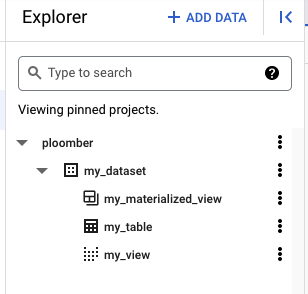
In the Cloud Storage console, you’ll see the HTML report:

Finally, if you download and open the HTML file, you’ll see the plot!

Incremental builds
It may take a few iterations to get the final analysis. This process involves making small changes to your code and rerunning the workflow. Ploomber can keep track of source code changes to accelerate iterations, so it only executes outdated scripts next time. Enabling this requires a bit of extra configuration since Ploomber needs to store your pipeline’s metadata, we already pre-configured the same workflow, so it stores the metadata in a SQLite database, you can run it with the following command:
ploomber build --entry-point pipeline.incremental.yaml
If you run the command another time, you’ll see that it skips all tasks:
name Ran? Elapsed (s) Percentage
------------------------ ------ ------------- ------------
create-table False 0 0
create-view False 0 0
create-materialized-view False 0 0
dump-table False 0 0
plot False 0 0
Now try changing plot.py and rerun the pipeline; you’ll see that it skips
most tasks!
Closing remarks
This tutorial showed how to build maintainable and scalable data analysis pipelines on Google Cloud. Ploomber has many other features to simplify your workflow such as parametrization (store outputs on a different each time you run the pipeline), task parallelization, and even cloud execution (in case you need more power to run your Python scripts!).
Check out our documentation to learn more, and don’t hesitate to send us any questions!



